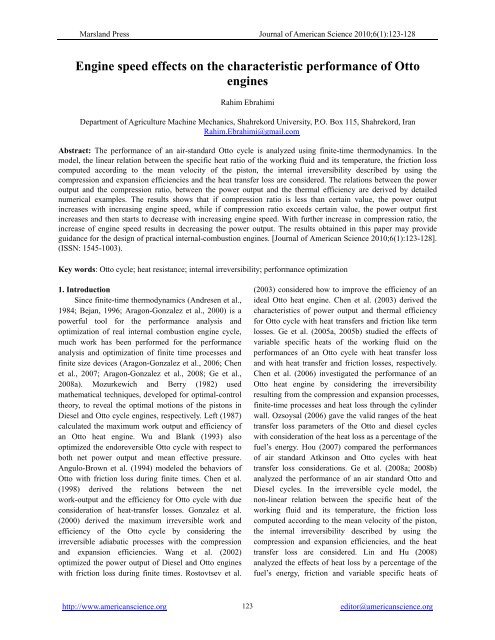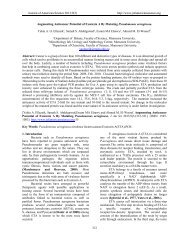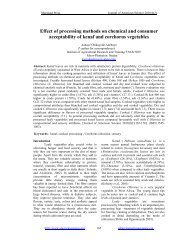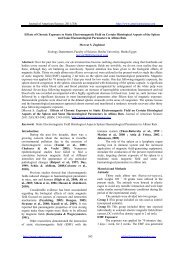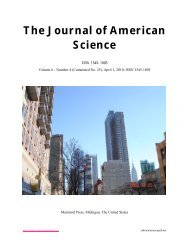Engine speed effects on the characteristic performance of Otto engines
Engine speed effects on the characteristic performance of Otto engines
Engine speed effects on the characteristic performance of Otto engines
Create successful ePaper yourself
Turn your PDF publications into a flip-book with our unique Google optimized e-Paper software.
Marsland Press Journal <strong>of</strong> American Science 2010;6(1):123-128<br />
<str<strong>on</strong>g>Engine</str<strong>on</strong>g> <str<strong>on</strong>g>speed</str<strong>on</strong>g> <str<strong>on</strong>g>effects</str<strong>on</strong>g> <strong>on</strong> <strong>the</strong> <strong>characteristic</strong> <strong>performance</strong> <strong>of</strong> <strong>Otto</strong><br />
<strong>engines</strong><br />
Rahim Ebrahimi<br />
Department <strong>of</strong> Agriculture Machine Mechanics, Shahrekord University, P.O. Box 115, Shahrekord, Iran<br />
Rahim.Ebrahimi@gmail.com<br />
Abstract: The <strong>performance</strong> <strong>of</strong> an air-standard <strong>Otto</strong> cycle is analyzed using finite-time <strong>the</strong>rmodynamics. In <strong>the</strong><br />
model, <strong>the</strong> linear relati<strong>on</strong> between <strong>the</strong> specific heat ratio <strong>of</strong> <strong>the</strong> working fluid and its temperature, <strong>the</strong> fricti<strong>on</strong> loss<br />
computed according to <strong>the</strong> mean velocity <strong>of</strong> <strong>the</strong> pist<strong>on</strong>, <strong>the</strong> internal irreversibility described by using <strong>the</strong><br />
compressi<strong>on</strong> and expansi<strong>on</strong> efficiencies and <strong>the</strong> heat transfer loss are c<strong>on</strong>sidered. The relati<strong>on</strong>s between <strong>the</strong> power<br />
output and <strong>the</strong> compressi<strong>on</strong> ratio, between <strong>the</strong> power output and <strong>the</strong> <strong>the</strong>rmal efficiency are derived by detailed<br />
numerical examples. The results shows that if compressi<strong>on</strong> ratio is less than certain value, <strong>the</strong> power output<br />
increases with increasing engine <str<strong>on</strong>g>speed</str<strong>on</strong>g>, while if compressi<strong>on</strong> ratio exceeds certain value, <strong>the</strong> power output first<br />
increases and <strong>the</strong>n starts to decrease with increasing engine <str<strong>on</strong>g>speed</str<strong>on</strong>g>. With fur<strong>the</strong>r increase in compressi<strong>on</strong> ratio, <strong>the</strong><br />
increase <strong>of</strong> engine <str<strong>on</strong>g>speed</str<strong>on</strong>g> results in decreasing <strong>the</strong> power output. The results obtained in this paper may provide<br />
guidance for <strong>the</strong> design <strong>of</strong> practical internal-combusti<strong>on</strong> <strong>engines</strong>. [Journal <strong>of</strong> American Science 2010;6(1):123-128].<br />
(ISSN: 1545-1003).<br />
Key words: <strong>Otto</strong> cycle; heat resistance; internal irreversibility; <strong>performance</strong> optimizati<strong>on</strong><br />
1. Introducti<strong>on</strong><br />
Since finite-time <strong>the</strong>rmodynamics (Andresen et al.,<br />
1984; Bejan, 1996; Arag<strong>on</strong>-G<strong>on</strong>zalez et al., 2000) is a<br />
powerful tool for <strong>the</strong> <strong>performance</strong> analysis and<br />
optimizati<strong>on</strong> <strong>of</strong> real internal combusti<strong>on</strong> engine cycle,<br />
much work has been performed for <strong>the</strong> <strong>performance</strong><br />
analysis and optimizati<strong>on</strong> <strong>of</strong> finite time processes and<br />
finite size devices (Arag<strong>on</strong>-G<strong>on</strong>zalez et al., 2006; Chen<br />
et al., 2007; Arag<strong>on</strong>-G<strong>on</strong>zalez et al., 2008; Ge et al.,<br />
2008a). Mozurkewich and Berry (1982) used<br />
ma<strong>the</strong>matical techniques, developed for optimal-c<strong>on</strong>trol<br />
<strong>the</strong>ory, to reveal <strong>the</strong> optimal moti<strong>on</strong>s <strong>of</strong> <strong>the</strong> pist<strong>on</strong>s in<br />
Diesel and <strong>Otto</strong> cycle <strong>engines</strong>, respectively. Left (1987)<br />
calculated <strong>the</strong> maximum work output and efficiency <strong>of</strong><br />
an <strong>Otto</strong> heat engine. Wu and Blank (1993) also<br />
optimized <strong>the</strong> endoreversible <strong>Otto</strong> cycle with respect to<br />
both net power output and mean effective pressure.<br />
Angulo-Brown et al. (1994) modeled <strong>the</strong> behaviors <strong>of</strong><br />
<strong>Otto</strong> with fricti<strong>on</strong> loss during finite times. Chen et al.<br />
(1998) derived <strong>the</strong> relati<strong>on</strong>s between <strong>the</strong> net<br />
work-output and <strong>the</strong> efficiency for <strong>Otto</strong> cycle with due<br />
c<strong>on</strong>siderati<strong>on</strong> <strong>of</strong> heat-transfer losses. G<strong>on</strong>zalez et al.<br />
(2000) derived <strong>the</strong> maximum irreversible work and<br />
efficiency <strong>of</strong> <strong>the</strong> <strong>Otto</strong> cycle by c<strong>on</strong>sidering <strong>the</strong><br />
irreversible adiabatic processes with <strong>the</strong> compressi<strong>on</strong><br />
and expansi<strong>on</strong> efficiencies. Wang et al. (2002)<br />
optimized <strong>the</strong> power output <strong>of</strong> Diesel and <strong>Otto</strong> <strong>engines</strong><br />
with fricti<strong>on</strong> loss during finite times. Rostovtsev et al.<br />
(2003) c<strong>on</strong>sidered how to improve <strong>the</strong> efficiency <strong>of</strong> an<br />
ideal <strong>Otto</strong> heat engine. Chen et al. (2003) derived <strong>the</strong><br />
<strong>characteristic</strong>s <strong>of</strong> power output and <strong>the</strong>rmal efficiency<br />
for <strong>Otto</strong> cycle with heat transfers and fricti<strong>on</strong> like term<br />
losses. Ge et al. (2005a, 2005b) studied <strong>the</strong> <str<strong>on</strong>g>effects</str<strong>on</strong>g> <strong>of</strong><br />
variable specific heats <strong>of</strong> <strong>the</strong> working fluid <strong>on</strong> <strong>the</strong><br />
<strong>performance</strong>s <strong>of</strong> an <strong>Otto</strong> cycle with heat transfer loss<br />
and with heat transfer and fricti<strong>on</strong> losses, respectively.<br />
Chen et al. (2006) investigated <strong>the</strong> <strong>performance</strong> <strong>of</strong> an<br />
<strong>Otto</strong> heat engine by c<strong>on</strong>sidering <strong>the</strong> irreversibility<br />
resulting from <strong>the</strong> compressi<strong>on</strong> and expansi<strong>on</strong> processes,<br />
finite-time processes and heat loss through <strong>the</strong> cylinder<br />
wall. Ozsoysal (2006) gave <strong>the</strong> valid ranges <strong>of</strong> <strong>the</strong> heat<br />
transfer loss parameters <strong>of</strong> <strong>the</strong> <strong>Otto</strong> and diesel cycles<br />
with c<strong>on</strong>siderati<strong>on</strong> <strong>of</strong> <strong>the</strong> heat loss as a percentage <strong>of</strong> <strong>the</strong><br />
fuel’s energy. Hou (2007) compared <strong>the</strong> <strong>performance</strong>s<br />
<strong>of</strong> air standard Atkins<strong>on</strong> and <strong>Otto</strong> cycles with heat<br />
transfer loss c<strong>on</strong>siderati<strong>on</strong>s. Ge et al. (2008a; 2008b)<br />
analyzed <strong>the</strong> <strong>performance</strong> <strong>of</strong> an air standard <strong>Otto</strong> and<br />
Diesel cycles. In <strong>the</strong> irreversible cycle model, <strong>the</strong><br />
n<strong>on</strong>-linear relati<strong>on</strong> between <strong>the</strong> specific heat <strong>of</strong> <strong>the</strong><br />
working fluid and its temperature, <strong>the</strong> fricti<strong>on</strong> loss<br />
computed according to <strong>the</strong> mean velocity <strong>of</strong> <strong>the</strong> pist<strong>on</strong>,<br />
<strong>the</strong> internal irreversibility described by using <strong>the</strong><br />
compressi<strong>on</strong> and expansi<strong>on</strong> efficiencies, and <strong>the</strong> heat<br />
transfer loss are c<strong>on</strong>sidered. Lin and Hu (2008)<br />
analyzed <strong>the</strong> <str<strong>on</strong>g>effects</str<strong>on</strong>g> <strong>of</strong> heat loss by a percentage <strong>of</strong> <strong>the</strong><br />
fuel’s energy, fricti<strong>on</strong> and variable specific heats <strong>of</strong><br />
http://www.americanscience.org 123<br />
editor@americanscience.org
<str<strong>on</strong>g>Engine</str<strong>on</strong>g> <str<strong>on</strong>g>speed</str<strong>on</strong>g> <str<strong>on</strong>g>effects</str<strong>on</strong>g> <strong>on</strong> <strong>the</strong> <strong>performance</strong> <strong>of</strong> <strong>Otto</strong> <strong>engines</strong> Rahim Ebrahimi<br />
working fluid <strong>on</strong> <strong>the</strong> <strong>performance</strong> <strong>of</strong> an air standard<br />
<strong>Otto</strong> cycle with a restricti<strong>on</strong> <strong>of</strong> maximum cycle<br />
temperature. Gumus (2009) studied <strong>the</strong> <strong>performance</strong><br />
analysis for an <strong>Otto</strong> cycle based <strong>on</strong> alternative<br />
<strong>performance</strong> criteria namely maximum power,<br />
maximum power density and maximum efficient power.<br />
As can be seen in <strong>the</strong> relevant literature, <strong>the</strong><br />
investigati<strong>on</strong> <strong>of</strong> <strong>the</strong> effect <strong>of</strong> engine <str<strong>on</strong>g>speed</str<strong>on</strong>g> <strong>on</strong><br />
<strong>performance</strong> <strong>of</strong> <strong>Otto</strong> cycle does not appear to have been<br />
published. Therefore, <strong>the</strong> objective <strong>of</strong> this study is to<br />
examine <strong>the</strong> effect <strong>of</strong> engine <str<strong>on</strong>g>speed</str<strong>on</strong>g> <strong>on</strong> <strong>performance</strong> <strong>of</strong><br />
air standard <strong>Otto</strong> cycle.<br />
2. Thermodynamic analysis<br />
The temperature-entropy diagram <strong>of</strong> an<br />
irreversible <strong>Otto</strong> heat engine is shown in Fig. 1, where<br />
T1 , 2s<br />
T , 2 , 3 , 4 and 4<br />
T T T T s are <strong>the</strong> temperatures <strong>of</strong> <strong>the</strong><br />
working substance in state points 1, 2s, 2, 3, 4 and 4s.<br />
Process 1→ 2sis<br />
a reversible adiabatic compressi<strong>on</strong>,<br />
1→2 while process is an irreversible adiabatic process<br />
that takes into account <strong>the</strong> internal irreversibility in <strong>the</strong><br />
real compressi<strong>on</strong> process. The heat additi<strong>on</strong> is an<br />
isochoric process 2→3. Process 3→4sis a reversible<br />
adiabatic expansi<strong>on</strong>, while 3 → 4 is an irreversible<br />
adiabatic process that takes into account <strong>the</strong> internal<br />
irreversibility in <strong>the</strong> real expansi<strong>on</strong> process. The<br />
heat-removing process is <strong>the</strong> reversible c<strong>on</strong>stant volume<br />
4→1. T<br />
3<br />
Temperature<br />
2s<br />
1<br />
2<br />
Entropy S<br />
Figure 1. temperature-entropy diagram for <strong>the</strong> air standard<br />
<strong>Otto</strong> cycle<br />
In a real cycle, <strong>the</strong> specific heat ratio is generally<br />
modeled as <strong>the</strong> first order equati<strong>on</strong> <strong>of</strong> mean charge<br />
temperature (Gatowski, et al., 1984; Brunt, et al., 1998;<br />
Ebrahimi, 2006). Thus, it can be supposed that <strong>the</strong><br />
specific heat ratio <strong>of</strong> <strong>the</strong> working fluid is functi<strong>on</strong> <strong>of</strong><br />
temperature al<strong>on</strong>e and has <strong>the</strong> first order equati<strong>on</strong><br />
4s<br />
4<br />
forms:<br />
γ = γ − kT<br />
(1)<br />
o 1<br />
where γ is <strong>the</strong> specific heat ratio and T is <strong>the</strong><br />
absolute temperature. γ o and k1<br />
are c<strong>on</strong>stants.<br />
The heat added per sec<strong>on</strong>d in <strong>the</strong> isobaric ( 2 → 3)<br />
heat additi<strong>on</strong> process may be written as:<br />
T3 T3⎛<br />
R ⎞<br />
Qin = Mn∫ cvdT = Mn T ∫ ⎜ ⎟dT<br />
=<br />
2 T2<br />
⎝γo−kT 1 −1⎠<br />
(2)<br />
MR ⎛ n γ kT 1 2 1⎞<br />
o − −<br />
ln ⎜ ⎟<br />
k1 ⎝γo−kT 1 4 −1⎠<br />
where M n is <strong>the</strong> molar number <strong>of</strong> <strong>the</strong> working<br />
fluid which is functi<strong>on</strong> <strong>of</strong> engine <str<strong>on</strong>g>speed</str<strong>on</strong>g>. R and c v are<br />
molar gas c<strong>on</strong>stant and molar specific heat at c<strong>on</strong>stant<br />
pressure for <strong>the</strong> working fluid, respectively.<br />
The heat rejected per sec<strong>on</strong>d in <strong>the</strong> isochoric heat<br />
rejecti<strong>on</strong> process ( 4→1) may be written as:<br />
T4 T4⎛<br />
R ⎞ air<br />
Qout = Mn∫ cvdT = Mn T ∫ ⎜ ⎟dT<br />
=<br />
1 T1<br />
⎝γo−kT 1 −1⎠<br />
(3)<br />
MR ⎛ n γ kT 1 1 1 ⎞<br />
o − −<br />
ln ⎜ ⎟<br />
k1 ⎝γo−kT 1 4 −1⎠<br />
For <strong>the</strong> two reversible adiabatic processes 1→2s and 3→ 4s,<br />
<strong>the</strong> compressi<strong>on</strong> and expansi<strong>on</strong> efficiencies<br />
can be defined as(Ge et al., 2008a; Ge et al., 2008b; Lin<br />
and Hou, 2008):<br />
η c = ( T2s −T1) ( T2 − T1)<br />
(4)<br />
and<br />
η e = ( T4 −T3) ( T4s − T3)<br />
(5)<br />
These two efficiencies can be used to describe <strong>the</strong><br />
internal irreversibility <strong>of</strong> <strong>the</strong> processes.<br />
Since p c and c v are dependent <strong>on</strong> temperature,<br />
<strong>the</strong> adiabatic exp<strong>on</strong>ent γ will vary with temperature as<br />
well. Therefore, <strong>the</strong> equati<strong>on</strong> <strong>of</strong>ten used in a reversible<br />
adiabatic process with c<strong>on</strong>stant γ cannot be used in a<br />
reversible adiabatic process with variable γ . However,<br />
according to Refs. (Ge et al. 2007; Chen et al., 2008),<br />
<strong>the</strong> equati<strong>on</strong> for a reversible adiabatic process with<br />
variable γ can be written as follows:<br />
1<br />
1<br />
TV ( T dT )( V dV )<br />
γ<br />
γ − −<br />
= + + (6)<br />
From Eq. (6), <strong>on</strong>e gets<br />
1<br />
Ti( kT 1 j 1) Tj ( kT 1 i 1 )( Vj / Vi) γ o −<br />
γo− − = γo−<br />
−<br />
(7)<br />
The compressi<strong>on</strong> ratio, rc<br />
, is defined as:<br />
rc= V1 V<br />
(8)<br />
2<br />
Therefore, <strong>the</strong> equati<strong>on</strong>s for processes (1→2s) and<br />
( 3→4s) are shown, respectively, by <strong>the</strong> following:<br />
γ o −1<br />
T1( γo−kT 1 2s − 1)( rc) = T2s( γo<br />
−kT 1 1−1)<br />
(9)<br />
and<br />
http://www.americanscience.org 124<br />
editor@americanscience.org
Marsland Press Journal <strong>of</strong> American Science 2010;6(1):123-128<br />
o −1<br />
3( γo− 1 4s − 1) = 4s( γo<br />
− 1 3 −1)(<br />
c)<br />
(10)<br />
T kT T kT r γ<br />
The energy transferred to <strong>the</strong> working fluid during<br />
combusti<strong>on</strong> is given by <strong>the</strong> following linear relati<strong>on</strong><br />
(Chen et al., 2008; Ebrahimi, 2009b)<br />
Qin = Mn⎡⎣A− B( T2 + T4)<br />
⎤⎦ (11)<br />
where A and B are two c<strong>on</strong>stants related to<br />
combusti<strong>on</strong> and heat transfer which are functi<strong>on</strong> <strong>of</strong><br />
engine <str<strong>on</strong>g>speed</str<strong>on</strong>g>. From equati<strong>on</strong> (10), it can be seen that<br />
Qin c<strong>on</strong>tained two parts: <strong>the</strong> first part is M n A , <strong>the</strong><br />
released heat by combusti<strong>on</strong> per sec<strong>on</strong>d, and <strong>the</strong> sec<strong>on</strong>d<br />
part is <strong>the</strong> heat leak loss per sec<strong>on</strong>d, M nBT+T ( 2 4)<br />
.<br />
Taking into account <strong>the</strong> fricti<strong>on</strong> loss <strong>of</strong> <strong>the</strong> pist<strong>on</strong><br />
and assuming a dissipati<strong>on</strong> term represented by a<br />
fricti<strong>on</strong> force that is a linear functi<strong>on</strong> <strong>of</strong> <strong>the</strong> pist<strong>on</strong><br />
velocity gives (Chen et al., 2006; Ge et al. 2007;<br />
Ebrahimi, 2009a)<br />
dx<br />
fμ=− μv =− μ<br />
(12)<br />
dt<br />
where μ is <strong>the</strong> coefficient <strong>of</strong> fricti<strong>on</strong>, which takes<br />
into account <strong>the</strong> global losses, x is <strong>the</strong> pist<strong>on</strong>’s<br />
displacement and v is <strong>the</strong> pist<strong>on</strong>’s velocity. Therefore,<br />
<strong>the</strong> lost power due to fricti<strong>on</strong> is<br />
2<br />
dWμ ⎛dx ⎞<br />
2<br />
Pμ=<br />
=− μ ⎜ ⎟ =−μv<br />
(13)<br />
dt ⎝ dt ⎠<br />
Running at N cycles per sec<strong>on</strong>d, <strong>the</strong> mean<br />
velocity <strong>of</strong> <strong>the</strong> pist<strong>on</strong> is<br />
v = 4LN<br />
(14)<br />
where L is <strong>the</strong> total distance <strong>the</strong> pist<strong>on</strong> travels per<br />
cycle.<br />
Thus, <strong>the</strong> power output <strong>of</strong> <strong>the</strong> <strong>Otto</strong> cycle engine<br />
can be written as<br />
P = Q −Q − P =<br />
out in out<br />
μ<br />
MR⎡ ⎛ n γ kT 1 2 1⎞<br />
⎛<br />
o− − γo−kT<br />
1 1−1⎞⎤<br />
⎢ln ⎜ ⎟−ln⎜ ⎟⎥⎦⎥−<br />
k1 ⎢⎣ ⎝γo−kT 1 3 −1⎠ ⎝γo−kT 1 4 −1⎠<br />
(15)<br />
2<br />
16μ<br />
( LN )<br />
The efficiency <strong>of</strong> <strong>the</strong> <strong>Otto</strong> cycle engine is<br />
expressed by<br />
Qin −Qout −Pμ<br />
ηth<br />
= =<br />
Q<br />
⎡ ⎛γ kT 1 2 1⎞<br />
⎛<br />
o− − γo−kT<br />
1 1−1⎞⎤<br />
MR n ⎢ln ⎜ ⎟−ln⎜ ⎟⎦⎥−<br />
⎣ ⎝γo−kT 1 3−1⎠ ⎝γo−kT 1 4−1⎠<br />
1<br />
( )<br />
16k<br />
μ LN<br />
2<br />
in<br />
⎛γkT 1 2 1⎞<br />
o − −<br />
MR n ln ⎜ ⎟<br />
γ −kT −1<br />
⎝ o 1 3 ⎠<br />
(16)<br />
When rc , η c , η e and T 1 are given, T 2s can be<br />
obtained from Eq. (9), <strong>the</strong>n, substituting T 2s into Eq. (4)<br />
yields T2 . T3<br />
can be deduced by substituting Eq. (2)<br />
into Eq. (11).<br />
T 4s can be found from Eq. (10), and<br />
T4<br />
can be deduced by substituting T 4s into Eq. (5).<br />
Substituting T1 , 2 , and T into Eqs. (15) and (16),<br />
respectively, <strong>the</strong> power output and <strong>the</strong>rmal efficiency <strong>of</strong><br />
<strong>the</strong> <strong>Otto</strong> cycle engine can be obtained. Therefore, <strong>the</strong><br />
relati<strong>on</strong>s between <strong>the</strong> power output, <strong>the</strong> <strong>the</strong>rmal<br />
efficiency and <strong>the</strong> compressi<strong>on</strong> ratio can be derived.<br />
T 3 T 4<br />
3. Results and discussi<strong>on</strong><br />
The following c<strong>on</strong>stants and parameters have been<br />
1<br />
used in this exercise: M n 1.57E 5 Nkmols −<br />
= − ×<br />
−5 −1<br />
η c = 0.97 η e = 0.97 k1= 7.18× 10 K γ o = 1.41<br />
1<br />
A 60000 J. mol −<br />
,<br />
, , , ,<br />
−1 −1<br />
= , L= 70 mm , B = 28 Jmol . K ,<br />
−5 −1<br />
b=− 9.7617× 10 K , N = 2000 − 6000 rpm , r c = 1−70 ,<br />
−1<br />
μ = 12.9 Nsm and T1= 300 K (Heywood, 1988; Chen<br />
et al. 2007; Ghatak and Chakraborty, 2007; Ge et al.,<br />
2008b; Ebrahimi, 2009a). Using <strong>the</strong> above c<strong>on</strong>stants<br />
and range <strong>of</strong> parameters, <strong>the</strong> power output versus<br />
compressi<strong>on</strong> ratio <strong>characteristic</strong> and <strong>the</strong> power output<br />
versus efficiency <strong>characteristic</strong> with varying <strong>the</strong> engine<br />
<str<strong>on</strong>g>speed</str<strong>on</strong>g> can be plotted. Numerical examples are shown as<br />
follows.<br />
Figures 2 and 3 show <strong>the</strong> <str<strong>on</strong>g>effects</str<strong>on</strong>g> <strong>of</strong> <strong>the</strong> variable<br />
engine <str<strong>on</strong>g>speed</str<strong>on</strong>g> <strong>on</strong> <strong>the</strong> cycle <strong>performance</strong> with heat<br />
resistance, internal irreversibility and fricti<strong>on</strong> losses.<br />
From <strong>the</strong>se figures, it can be found that <strong>the</strong> engine <str<strong>on</strong>g>speed</str<strong>on</strong>g><br />
plays important roles <strong>on</strong> <strong>the</strong> power output. It is clearly<br />
seen that <strong>the</strong> effect <strong>of</strong> engine <str<strong>on</strong>g>speed</str<strong>on</strong>g> <strong>on</strong> <strong>the</strong> power output<br />
is related to compressi<strong>on</strong> ratio. They reflect <strong>the</strong><br />
<strong>performance</strong> <strong>characteristic</strong>s <strong>of</strong> a real irreversible <strong>Otto</strong><br />
cycle engine. It should be noted that <strong>the</strong> heat added and<br />
<strong>the</strong> heat rejected by <strong>the</strong> working fluid increase with<br />
increasing engine <str<strong>on</strong>g>speed</str<strong>on</strong>g> (see Eqs. (2) and (3)).<br />
Figure 3 indicates <strong>the</strong> <str<strong>on</strong>g>effects</str<strong>on</strong>g> <strong>of</strong> <strong>the</strong> engine <str<strong>on</strong>g>speed</str<strong>on</strong>g><br />
<strong>on</strong> <strong>the</strong> power output <strong>of</strong> <strong>the</strong> cycle for different values <strong>of</strong><br />
<strong>the</strong> compressi<strong>on</strong> ratio. It can be seen that <strong>the</strong> power<br />
output versus compressi<strong>on</strong> ratio <strong>characteristic</strong> is<br />
approximately parabolic like curves. In o<strong>the</strong>r word, <strong>the</strong><br />
power output increases with increasing compressi<strong>on</strong><br />
ratio, reach <strong>the</strong>ir maximum values and <strong>the</strong>n decreases<br />
with fur<strong>the</strong>r increase in compressi<strong>on</strong> ratio. The<br />
maximum power output increases with increasing<br />
engine <str<strong>on</strong>g>speed</str<strong>on</strong>g> up to about 5000 rpm where it reaches its<br />
peak value <strong>the</strong>n starts to decline as <strong>the</strong> engine <str<strong>on</strong>g>speed</str<strong>on</strong>g><br />
increases. This is c<strong>on</strong>sistent with <strong>the</strong> experimental<br />
results in <strong>the</strong> internal combusti<strong>on</strong> engine (Mercier,<br />
2006).<br />
The optimal compressi<strong>on</strong> ratio corresp<strong>on</strong>ding to<br />
maximum power output point remains c<strong>on</strong>stant with<br />
increase <strong>of</strong> engine <str<strong>on</strong>g>speed</str<strong>on</strong>g>. The working range <strong>of</strong> <strong>the</strong><br />
http://www.americanscience.org 125<br />
editor@americanscience.org
<str<strong>on</strong>g>Engine</str<strong>on</strong>g> <str<strong>on</strong>g>speed</str<strong>on</strong>g> <str<strong>on</strong>g>effects</str<strong>on</strong>g> <strong>on</strong> <strong>the</strong> <strong>performance</strong> <strong>of</strong> <strong>Otto</strong> <strong>engines</strong> Rahim Ebrahimi<br />
Power output (kW)<br />
Power output (kW)<br />
6<br />
5<br />
4<br />
3<br />
2<br />
1<br />
N = 4000rpm<br />
N = 6000rpm<br />
N = 5000rpm<br />
N = 3000rpm<br />
N = 2000rpm<br />
0<br />
0 10 20 30 40 50 60 70<br />
Compressi<strong>on</strong> ratio<br />
6<br />
5<br />
4<br />
3<br />
2<br />
1<br />
N = 6000rpm<br />
Figure 1. Effect <strong>of</strong> <strong>on</strong> <strong>the</strong><br />
N = 5000rpm<br />
N Pout rc<br />
− <strong>characteristic</strong><br />
N = 4000rpm<br />
0<br />
0 10 20 30 40<br />
Thermal efficiency (%)<br />
Figure 2. Effect <strong>of</strong> <strong>on</strong> <strong>the</strong><br />
N out th<br />
P − η <strong>characteristic</strong><br />
N = 3000 rpm<br />
N = 2000rpm<br />
http://www.americanscience.org 126<br />
editor@americanscience.org<br />
50
Marsland Press Journal <strong>of</strong> American Science 2010;6(1):123-128<br />
cycle decreases as <strong>the</strong> engine <str<strong>on</strong>g>speed</str<strong>on</strong>g> increases. The<br />
results shows that if compressi<strong>on</strong> ratio is less than<br />
certain value, <strong>the</strong> power output increases with<br />
increasing engine <str<strong>on</strong>g>speed</str<strong>on</strong>g>, while if compressi<strong>on</strong> ratio<br />
exceeds certain value, <strong>the</strong> power output first increases<br />
and <strong>the</strong>n starts to decrease with increasing engine <str<strong>on</strong>g>speed</str<strong>on</strong>g>.<br />
With fur<strong>the</strong>r increase in compressi<strong>on</strong> ratio, <strong>the</strong> increase<br />
<strong>of</strong> engine <str<strong>on</strong>g>speed</str<strong>on</strong>g> results in decreasing <strong>the</strong> power output.<br />
Numerical calculati<strong>on</strong> shows that for any same<br />
compressi<strong>on</strong> ratio, <strong>the</strong> smallest power output is for<br />
N = 6000rpm<br />
when rc ≤ 5.2 or and is for<br />
N = 2000rpm<br />
when 5.2 c and also <strong>the</strong> largest<br />
power output is for when or<br />
r c > 38.6 , is for when or<br />
23.4 ≤rc≤38.6 and is for when<br />
3.6 ≤ rc<br />
< 23.4 .<br />
m<br />
m<br />
r<br />
r c > 15.7<br />
< ≤15.7<br />
N = 2000rpm<br />
rc ≤ 2.2<br />
N = 3000rpm<br />
2.2 < rc<br />
≤3.6<br />
N = 6000rpm<br />
The influence <strong>of</strong> <strong>the</strong> engine <str<strong>on</strong>g>speed</str<strong>on</strong>g> <strong>on</strong> <strong>the</strong> power<br />
output versus <strong>the</strong>rmal efficiency is displayed in figure 4.<br />
As can be seen from this figure, <strong>the</strong> power output versus<br />
<strong>the</strong>rmal efficiency is loop shaped <strong>on</strong>e. It can be seen<br />
that <strong>the</strong> power output at maximum <strong>the</strong>rmal efficiency<br />
improves with increasing engine <str<strong>on</strong>g>speed</str<strong>on</strong>g> from 2000 to<br />
around N = 4000rp<br />
. With fur<strong>the</strong>r increase in engine<br />
<str<strong>on</strong>g>speed</str<strong>on</strong>g>, <strong>the</strong> power output at maximum <strong>the</strong>rmal efficiency<br />
decreases. It can also be seen that <strong>the</strong> <strong>the</strong>rmal efficiency<br />
at maximum power decreases with increase <strong>of</strong> engine<br />
<str<strong>on</strong>g>speed</str<strong>on</strong>g> from 2000 to N = 6000rp<br />
.<br />
According to above analysis, it can be found that<br />
<strong>the</strong> <str<strong>on</strong>g>effects</str<strong>on</strong>g> <strong>of</strong> <strong>the</strong> engine <str<strong>on</strong>g>speed</str<strong>on</strong>g> <strong>on</strong> <strong>the</strong> cycle <strong>performance</strong><br />
are obvious, and <strong>the</strong>y should be c<strong>on</strong>sidered in practice<br />
cycle analysis in order to make <strong>the</strong> cycle model be more<br />
close to practice.<br />
4. C<strong>on</strong>clusi<strong>on</strong><br />
An air standard <strong>Otto</strong> cycle model, assuming a<br />
temperature dependent specific heat ratio <strong>of</strong> <strong>the</strong> working<br />
fluid, and heat resistance and fricti<strong>on</strong>al irreversible<br />
losses, has been investigated numerically. The<br />
<strong>performance</strong> <strong>characteristic</strong>s <strong>of</strong> <strong>the</strong> cycle with varying<br />
engine <str<strong>on</strong>g>speed</str<strong>on</strong>g>s and compressi<strong>on</strong> ratios were obtained by<br />
numerical examples. The results show that if<br />
compressi<strong>on</strong> ratio is less than certain value, <strong>the</strong> power<br />
output increases with increasing engine <str<strong>on</strong>g>speed</str<strong>on</strong>g>, while if<br />
compressi<strong>on</strong> ratio exceeds certain value, <strong>the</strong> power<br />
output first increases and <strong>the</strong>n starts to decrease with<br />
increasing engine <str<strong>on</strong>g>speed</str<strong>on</strong>g>. With fur<strong>the</strong>r increase in<br />
compressi<strong>on</strong> ratio, <strong>the</strong> increase <strong>of</strong> engine <str<strong>on</strong>g>speed</str<strong>on</strong>g> results<br />
in decreasing <strong>the</strong> power output. The results also show<br />
that <strong>the</strong> maximum power output increase with<br />
increasing engine <str<strong>on</strong>g>speed</str<strong>on</strong>g>. With fur<strong>the</strong>r increase in engine<br />
<str<strong>on</strong>g>speed</str<strong>on</strong>g>, <strong>the</strong> increase <strong>of</strong> engine <str<strong>on</strong>g>speed</str<strong>on</strong>g> results in decreasing<br />
<strong>the</strong> maximum power output. The analysis helps us to<br />
understand <strong>the</strong> str<strong>on</strong>g effect <strong>of</strong> engine <str<strong>on</strong>g>speed</str<strong>on</strong>g> <strong>on</strong> <strong>the</strong><br />
<strong>performance</strong> <strong>of</strong> <strong>the</strong> <strong>Otto</strong> cycle. Therefore, <strong>the</strong> results are<br />
<strong>of</strong> great significance to provide good guidance for <strong>the</strong><br />
<strong>performance</strong> evaluati<strong>on</strong> and improvement <strong>of</strong> real <strong>Otto</strong><br />
<strong>engines</strong>.<br />
Corresp<strong>on</strong>dence to:<br />
Rahim Ebrahimi<br />
Department <strong>of</strong> Agriculture Machine Mechanics<br />
Shahrekord University, P.O. Box 115<br />
Shahrekord, Iran<br />
Tel/Fax: 0098-381-4424412<br />
Email:Rahim.Ebrahimi@gmail.com<br />
References<br />
[1] Andresen, B., Berry, R.S., Ondrechen, M.J., Salam<strong>on</strong>, P.<br />
Thermodynamics for processes in finite time. Acc. Chem. Res.<br />
1984, 17, 266-271<br />
[2] Angulo-Brown, F., Fernandez-Betanzos, J., Diaz-Pico, C.A.<br />
Compressi<strong>on</strong> ratio <strong>of</strong> an optimized air standard <strong>Otto</strong> cycle<br />
model. Eur. J. Phys. 1994, 16, 38-42.<br />
[3] Arag<strong>on</strong>-G<strong>on</strong>zalez, G., Ganales-Palma, A., Le<strong>on</strong>-Galicia, A.,<br />
Maximum irreversible work and efficiency in power cycles. J.<br />
Phys. D: Appl. Phys. 2000, 33(11), 1403–1409.<br />
[4] Arag<strong>on</strong>-G<strong>on</strong>zalez, G., Canales-Palma, A., Le<strong>on</strong>-Galicia, A.,<br />
Morales-Gomez, J.R., Optimizati<strong>on</strong> <strong>of</strong> an irreversible Carnot<br />
engine in finite time and finite size. Revista Mexicana de<br />
Fisica. 2006; 52 (4), 309–314<br />
[5] Arag<strong>on</strong>-G<strong>on</strong>zalez, G., Canales-Palma, A., Le<strong>on</strong>-Galicia, A.,<br />
Morales-Gomez, J.R. Maximum Power, Ecological Functi<strong>on</strong><br />
and Efficiency <strong>of</strong> an Irreversible Carnot Cycle. A Cost and<br />
Effectiveness Optimizati<strong>on</strong>, Brazilian J. phys. 2008, 38(4),<br />
543-550.<br />
[6] Bejan, A. Entropy-generati<strong>on</strong> minimizati<strong>on</strong>: <strong>the</strong> new<br />
<strong>the</strong>rmodynamics <strong>of</strong> finite-size device and finite-time processes.<br />
J. Appl. Phys. 1996, 79(3), 1191–218.<br />
[7] Brunt, M.F.J., Rai, H., Emtage, A.L. The calculati<strong>on</strong> <strong>of</strong> heat<br />
release energy from engine cylinder pressure data. SAE Paper<br />
No. 981052. 1998.<br />
[8] Chen, L., Wu, C., Sun, F., Cao, S. Heat-transfer <str<strong>on</strong>g>effects</str<strong>on</strong>g> <strong>on</strong> <strong>the</strong><br />
net work-output and efficiency <strong>characteristic</strong>s for an air<br />
standard <strong>Otto</strong> cycle. Energ C<strong>on</strong>versi<strong>on</strong> Management 1998,<br />
39(7), 643–8.<br />
[9] Chen, J., Zhao, Y., He, J. Optimizati<strong>on</strong> criteria for <strong>the</strong> important<br />
parameters <strong>of</strong> an irreversible <strong>Otto</strong> heat-engine. Appl. Energy,<br />
2006, 83, 228–238.<br />
http://www.americanscience.org 127<br />
editor@americanscience.org
<str<strong>on</strong>g>Engine</str<strong>on</strong>g> <str<strong>on</strong>g>speed</str<strong>on</strong>g> <str<strong>on</strong>g>effects</str<strong>on</strong>g> <strong>on</strong> <strong>the</strong> <strong>performance</strong> <strong>of</strong> <strong>Otto</strong> <strong>engines</strong> Rahim Ebrahimi<br />
[10] Chen, L., Zheng, T., Sun, F., Wu, C. The power and efficiency<br />
<strong>characteristic</strong>s for an irreversible <strong>Otto</strong> cycle. Int. J. Ambient.<br />
Energy 2003, 24, 195–200.<br />
[11] Chen, L., Ge, Y., Sun, F. Unified <strong>the</strong>rmodynamic descripti<strong>on</strong><br />
and optimizati<strong>on</strong> for a class <strong>of</strong> irreversible reciprocating heat<br />
engine cycles. Proc. IMechE Part D: J. Automobile<br />
<str<strong>on</strong>g>Engine</str<strong>on</strong>g>ering. 2008, 222, 1489-1500.<br />
[12] Chen, L., Ge, Y., Sun, F., Wu, C. Effects <strong>of</strong> heat transfer,<br />
fricti<strong>on</strong> and variable specific heats <strong>of</strong> working fluid <strong>on</strong><br />
<strong>performance</strong> <strong>of</strong> an irreversible dual cycle. Energy C<strong>on</strong>versi<strong>on</strong><br />
and Management 2006, 47, 3224–34.<br />
[13] Ebrahimi, R. Experimental study <strong>on</strong> <strong>the</strong> auto igniti<strong>on</strong> in HCCI<br />
engine, Ph.D. Thesis, Valenciennes et du Hainaut-Cambrésis,<br />
France, 2006 (In French).<br />
[14] Ebrahimi, R. Effects <strong>of</strong> cut-<strong>of</strong>f ratio <strong>on</strong> <strong>performance</strong> <strong>of</strong> an<br />
irreversible Dual cycle. Journal <strong>of</strong> American Science 2009a,<br />
5(3), 83-90.<br />
[15] Ebrahimi, R. Thermodynamic simulati<strong>on</strong> <strong>of</strong> <strong>performance</strong> <strong>of</strong> an<br />
endoreversible Dual cycle with variable specific heat ratio <strong>of</strong><br />
working fluid. Journal <strong>of</strong> American Science, 2009b, 5(5),<br />
175-180.<br />
[16] Gatowski, J.A., Balles, E.N., Chun, K.M., Nels<strong>on</strong>, F., Ekchian<br />
J.A., Heywood, F.B. A heat release analysis <strong>of</strong> engine pressure<br />
data. SAE Paper No, 841359. 1984.<br />
[17] Ghatak, A., Chakraborty, S. Effect <strong>of</strong> external irreversibilities<br />
and variable <strong>the</strong>rmal properties <strong>of</strong> working fluid <strong>on</strong> <strong>the</strong>rmal<br />
<strong>performance</strong> <strong>of</strong> a Dual internal combusti<strong>on</strong> engine cycle.<br />
Strojnicky Casopis (Journal Mechanical Energy), 2007, 58,<br />
1–12.<br />
[18] Ge, Y., Chen, L., Sun, F. Finite time <strong>the</strong>rmodynamic modeling<br />
and analysis <strong>of</strong> an irreversible <strong>Otto</strong> cycle. Applied Energy<br />
2008a, 85(7), 618-624.<br />
[19] Ge, Y., Chen, L., Sun, F. Finite time <strong>the</strong>rmodynamic modeling<br />
and analysis for an irreversible Diesel cycle. Proceedings<br />
IMechE, Part D: Journal <strong>of</strong> Automobile <str<strong>on</strong>g>Engine</str<strong>on</strong>g>ering 2008b,<br />
222(D5), 887-94.<br />
[20] Ge, Y., Chen, L., Sun, F., Wu, C., Thermodynamic simulati<strong>on</strong><br />
<strong>of</strong> <strong>performance</strong> <strong>of</strong> an <strong>Otto</strong> cycle with heat transfer and variable<br />
specific heats <strong>of</strong> working fluid. Int. J. Thermal Sci. 2005a, 44,<br />
9/26/2009<br />
506–511.<br />
[21] Ge, Y., Chen, L., Sun, F., Wu, C. The <str<strong>on</strong>g>effects</str<strong>on</strong>g> <strong>of</strong> variable<br />
specific-heats <strong>of</strong> <strong>the</strong> working fluid <strong>on</strong> <strong>the</strong> <strong>performance</strong> <strong>of</strong> an<br />
irreversible <strong>Otto</strong> cycle. Int J Exergy 2005b, 2(3), 274–83.<br />
[22] Ge, Y., Chen, L., Sun, F., Wu, C. Performance <strong>of</strong> diesel cycle<br />
with heat transfer, fricti<strong>on</strong> and variable specific heats <strong>of</strong><br />
working fluid. J. Energy Inst., 2007, 80(4), 239–242.<br />
[23] Gumus, M., Atmaca, M., Yilmaz, T. Efficiency <strong>of</strong> an <strong>Otto</strong><br />
engine under alternative power optimizati<strong>on</strong>s. Int. J. Energy<br />
Res., 2009, DOI: 10.1002/er.1515.<br />
[24] Heywood, J.B. Internal combusti<strong>on</strong> engine fundamentals.<br />
NewYork: McGraw Hill; 1988.<br />
[25] Left, H.S. Efficiency at maximum work output: new results<br />
for old heat <strong>engines</strong>. Am. J. Phys. 1987, 55, 602–610.<br />
[26] Lin, J., Hou, S. Effects <strong>of</strong> heat loss as percentage <strong>of</strong> fuel’s<br />
energy, fricti<strong>on</strong> and variable specific heats <strong>of</strong> working fluid <strong>on</strong><br />
<strong>performance</strong> <strong>of</strong> air standard <strong>Otto</strong> cycle. Energy C<strong>on</strong>v. Manage.<br />
2008, 49, 1218–1227.<br />
[27] Mozurkewich, M., Berry, R. Optimal paths for <strong>the</strong>rmodynamic<br />
systems: <strong>the</strong> ideal <strong>Otto</strong> cycle. J. Appl. Phys. 1982, 53(1),<br />
34–42.<br />
[28] Mercier, M. C<strong>on</strong>tributi<strong>on</strong> to <strong>the</strong> study <strong>of</strong> <strong>the</strong> behavior <strong>of</strong> a<br />
spark igniti<strong>on</strong> engine fueled with Gr<strong>on</strong>ingen natural gas. PhD<br />
<strong>the</strong>sis Université de Valenciennes et du Hainaut Cambrésis<br />
France, 2006, (in French)<br />
[29] Ozsoysal, O.A. Heat loss as percentage <strong>of</strong> fuel’s energy in air<br />
standard <strong>Otto</strong> and diesel cycles. Energy C<strong>on</strong>versi<strong>on</strong> Managmt<br />
2006, 47(7–8), 1051–1062.<br />
[30] Rostovtsev, Y.V., Matsko, A.B., Nayak, N., Zubairy, M.S.,<br />
Scully, M.O. Improving <str<strong>on</strong>g>Engine</str<strong>on</strong>g> Efficiency by Extracting Laser<br />
Energy From Hot Exhaust Gas. Phys. Rev. A, 2003, 67,<br />
053811-1–053811-8.<br />
[31] Wang, W., Chen, L., Sun, F., Wu, C. The Effects <strong>of</strong> Fricti<strong>on</strong> <strong>on</strong><br />
<strong>the</strong> Performance <strong>of</strong> an Air Standard Dual Cycle. Exergy, 2002,<br />
2(4), 340–344.<br />
[32] Wu, C., Blank, D.A. Optimizati<strong>on</strong> <strong>of</strong> <strong>the</strong> endoreversible <strong>Otto</strong><br />
cycle with respect to both power and mean pressure. Energy<br />
C<strong>on</strong>vers. Mgnt. 1993, 34, 1255–1259.<br />
http://www.americanscience.org 128<br />
editor@americanscience.org


